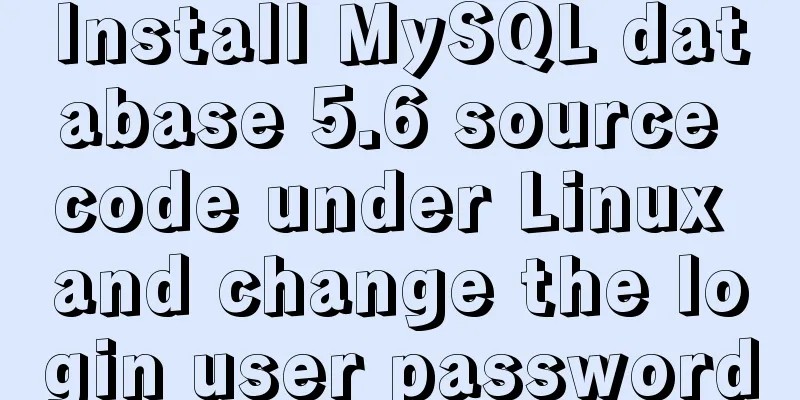Install MySQL database 5.6 source code under Linux and change the login user password

|
This article mainly explains how to install the MYSQL database under Linux, and uses the installation of MYSQL5.6 version as an example to teach you how to modify the login username and password. Source code download address http://dev.mysql.com/downloads/mysql/5.6.html#downloads tar.gz address: https://dev.mysql.com/get/Downloads/MySQL-5.6/mysql-5.6.37.tar.gz
Select Generic Linux (Architecture Independent), Compressed TAR Archive
Select No thanks, just start my download.
operating system: centos6.5 x86_64 1. Yum installation related dependencies # yum -y install gcc gcc-c++ gcc-g77 autoconf automake zlib* fiex* libxml* ncurses-devel libmcrypt* libtool-ltdl-devel* make cmake bison git openssl openssl-devel 2. Compile and install 1. Add users groupadd mysql useradd -r -g mysql mysql 2. Compile and install tar xf mysql-5.6.34.tar.gz cd mysql-5.6.34 #By default, it is installed in /usr/local/mysql # cmake compilation parameters can be adjusted by yourself ************************************************************** -- Looking for asprintf -- Looking for asprintf - found -- Check size of pthread_t -- Check size of pthread_t - done -- Using cmake version 2.8.12.2 -- Not building NDB --Performing Test HAVE_PEERCRED -- Performing Test HAVE_PEERCRED - Success -- Library mysqlclient depends on OSLIBS -lpthread;/usr/lib64/libz.so;m;rt;/usr/lib64/libssl.so;/usr/lib64/libcrypto.so;dl -- Googlemock was not found. gtest-based unit tests will be disabled. You can run cmake . -DENABLE_DOWNLOADS=1 to automatically download and build required components from source. -- If you are inside a firewall, you may need to use an http proxy: export http_proxy=http://example.com:80 -- Library mysqlserver depends on OSLIBS -lpthread;/usr/lib64/libz.so;m;rt;/usr/lib64/libssl.so;/usr/lib64/libcrypto.so;dl;crypt --CMAKE_BUILD_TYPE: RelWithDebInfo -- COMPILE_DEFINITIONS: HAVE_CONFIG_H -- CMAKE_C_FLAGS: -Wall -Wextra -Wformat-security -Wvla -Wwrite-strings -Wdeclaration-after-statement -- CMAKE_CXX_FLAGS: -Wall -Wextra -Wformat-security -Wvla -Woverloaded-virtual -Wno-unused-parameter -- CMAKE_C_FLAGS_RELWITHDEBINFO: -O3 -g -fabi-version=2 -fno-omit-frame-pointer -fno-strict-aliasing -DDBUG_OFF -- CMAKE_CXX_FLAGS_RELWITHDEBINFO: -O3 -g -fabi-version=2 -fno-omit-frame-pointer -fno-strict-aliasing -DDBUG_OFF -- Configuring done -- Generating done CMake Warning: Manually-specified variables were not used by the project: WITH_READLINE -- Build files have been written to: /root/mysql-5.6.34 ************************************************************** rm -f CMakeCache.txt 3.make && make install Note: When recompiling, old object files and cached information need to be cleared. # make clean # rm -f CMakeCache.txt # rm -rf /etc/my.cnf 4. Change the data storage directory owner to mysql chown -R mysql.mysql /usr/local/mysql chown -R mysql.mysql /data/mydata 5. Start the script to initialize the database cd /usr/local/mysql # scripts/mysql_install_db --user=mysql --basedir=/usr/local/mysql --datadir=/data/mydata 6. Registration Service cp support-files/mysql.server /etc/rc.d/init.d/mysqld #Use the default configuration file cp support-files/my-default.cnf /etc/my.cnf #Let chkconfig manage mysql service chkconfig --add mysqld #Startup chkconfig mysqld on Edit vi /etc/my.cnf configuration and add the following content innodb_file_per_table = 1 datadir = /data/mydata log-bin=/data/binlogs/mysql-bin Notice: After actual testing, the parameter innodb_file_per_table = ON requires innodb_file_per_table = 1 to take effect. mysql> show variables like '%per_table%'; to query mkdir /data/binlogs chown -R mysql.mysql /data/binlogs 8. Add the mysql command to the environment variable vim /etc/profile.d/mysql.sh join in export PATH=/usr/local/mysql/bin:$PATH The default password is empty 9 Modify vi /etc/security/limits.conf, then add the following content, log out and log in again (no need to restart, just exit the current connection shell) # ulimit -n Check whether the parameter is effective * hard nofile 655350 *soft nofile 655350 Otherwise, the error is as follows: Error #23: Out of resources when opening file './XX/USER.MYD' (Errcode: 24) at the same time vim /etc/security/limits.d/90-nproc.conf Delete the following line to remove centos's restrictions on file operation handles: * soft nproc 1024 About starting and stopping mysql /etc/init.d/mysqld start /etc/init.d/mysqld stop Check whether MySQL has been started successfully ps -elf |grep mysql |grep -v grep Change to allow IP access (enter mysql: 2. Use mysql library: 3. View user table: 4. Update user table: 5. Force refresh permissions:) /usr/local/mysql/bin/mysql -u root -p use mysql; SELECT `Host`,`User` FROM user; UPDATE user SET `Host` = '%' WHERE `User` = 'root' LIMIT 1; Change the password of the MySQL database login user. You can use the navcat client to connect and change the password of the login user. #mysql -uroot -p Enter password: [The default password for the original installation is left blank and the password is entered directly] mysql>use mysql; mysql> update user set password=passworD("root") where user='root'; mysql> flush privileges; mysql> exit; Before using the client connection test, be sure to open the connection port 3306 in the firewall vi /etc/sysconfig/iptables After port 22 -A INPUT -m state --state NEW -m tcp -p tcp --dport 3306 -j ACCEPT Restart the firewall to take effect service iptables restart You may also be interested in:
|
<<: Talk about nextTick in Vue
>>: Complete steps to build a squid proxy server in linux
Recommend
About MySQL innodb_autoinc_lock_mode
The innodb_autoinc_lock_mode parameter controls t...
Vue3.0 implements the encapsulation of the drop-down menu
Vue3.0 has been out for a while, and it is necess...
Script example for starting and stopping spring boot projects in Linux
There are three ways to start a springboot projec...
How to deploy egg applications on self-built Windows servers (with pictures and text)
1. Log in to VPN using IE browser 2. Remote login...
Methods for backing up Windows server files locally, Windows server data backup solutions
Important data must be backed up, and must be bac...
How to solve the abnormal error ERROR: 2002 in mysql
Recently, an error occurred while starting MySQL....
Solution to the Multiple primary key defined error in MySQL
There are two ways to create a primary key: creat...
How to make JavaScript sleep or wait
Table of contents Overview Checking setTimeout() ...
MySQL cursor detailed introduction
Table of contents 1. What is a cursor? 2. How to ...
Use of TypeScript Generics
Table of contents 1. Easy to use 2. Using generic...
A brief analysis of the problem of mysql being inaccessible when deployed with docker-compose
What is Docker-Compose The Compose project origin...
Detailed explanation of Vue's hash jump principle
Table of contents The difference between hash and...
How to purchase and install Alibaba Cloud servers
1. Purchase a server In the example, the server p...
How to implement Linux disk mounting, partitioning, and capacity expansion operations
Basic Concepts Before operation, you must first u...
Detailed explanation of the use of the MySQL parameter sql_safe_updates in the production environment
Preface In case of application bug or DBA misoper...












